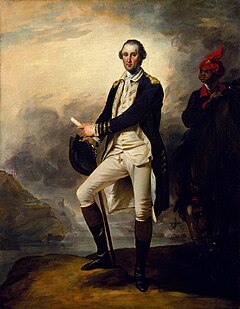William Lee (valet)
Will had but one order, which was to keep with the hounds; and, mounted on Chinkling, a French horn at his back, throwing himself almost at length on the animal, with his spur in flank, this fearless horseman would rush, at full speed, through brake or tangled wood, in a style at which modern huntsmen would stand aghast.
[4][5]The hunting horn aspect of William Lee's life and other Huntsmen of African and Creole descent are largely undocumented, but they are acknowledged as "exploited for the benefit of their indentures and enslavers.
"[6] Before the Revolutionary War, Lee often traveled with Washington to the House of Burgesses in Williamsburg, or on journeys such as a surveying expedition to the Ohio Valley in 1770 and to the First Continental Congress in Philadelphia in 1774.
[7] According to the historian Fritz Hirschfeld, Lee "rode alongside Washington in the thick of battle, ready to hand over to the general a spare horse or his telescope or whatever else might be needed.
Even after Washington's 1797 retirement, Lee's disabilities prevented him from continuing his previous duties, and he spent the last years of his life as a shoemaker at Mount Vernon and struggled with alcoholism.
"If Billy Lee had been a white man," wrote the historian Fritz Hirschfeld, "he would have had an honored place in American history because of his close proximity to George Washington during the most exciting periods of his career.

